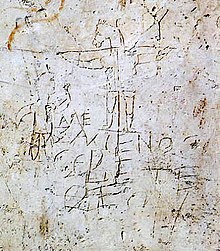Yes, horses and their relatives (asses and donkeys etc) have been important in human history and therefore (at times) worshipped.
Is it possible that above graffito was based on Alexamenos' worship of a 'horse/god?' It's difficult to say yes or no, without more information. For example, if we knew that Alexamenos was South Asian (Indian) in origin, then I could make a connection.
This is how it could be argued, the Romans were the western market tor the East-West Trade Network (the so-called Silk Road - see Revelation 18). It was difficult for the Romans to trade directly with China, Iran (under both the Parthians and Sasanians) blocked the way and exacted a high tariff. To bypass Iran, the Romans developed trade links with India. So we know it was possible (but not necessarily probable) for a South Asian to find himself in a Roman territory, and somehow become involved in some action that resulted in his enslavement. Being bought and sold a few times, its possible that he finished up as a slave in the Imperial household.
In south Asia, there was a horse-headed god.
Images from Wikipedia.
He was an avatar of Vishnu, named Hayagriva. Information about this god, has been traced back to circa 2000 BCE, among the Indo-Aryan people who were moving south from the central Asia steppes where horses were important.
But it can be appreciated that this interpretation is highly dependent on some coincidences required to explain how a horse worshipper finished up in the Imperial palace. And, it can be noted I offer no explanation as to why this possible explanation has the horse god portrayed as executed.
Compare that to the explanation offered by most scholars. We know that Christians were in Rome in the period most likely to have been the time in which the graffito was scrawled on the wall. No coincidences required. We know that (apparently) Alexamenos (who may have made the second inscription himself), clearly saw himself as a faithful worshipper. If he wrote the second inscription, 'Alexamenos fidelis' ( trans: Alexamenos is faithful) himself, it may have been his response to the first graffito. (Or, maybe another Christian wrote it to encourage him). The vocabulary fits what we know about early Christians.
So how could we explain the horse/ass head on the crucified 'god?'
Is there anything that connects a horse headed figure to early Christianity?
A Wikipedia entry on Alexamenos states:
"Tertullian, writing in the late 2nd or early 3rd century, reports that Christians, along with Jews, were accused of worshipping such a deity.
He also mentions an apostate Jew who carried around Carthage a caricature of a Christian with ass's ears and hooves, labeled Deus Christianorum Onocoetes ("the God of the Christians begotten of an ass")."
Link: https://en.wikipedia.org/wiki/Alexamenos_graffito
It is (as acknowledged) quite difficult to assert one interpretation as being the only possible explanation.
But it is possible to think through as to which explanation seems more likely.



